 |
 |
|
Home
Links

Nose art of VMO-6 during 1967, displaying
the aircraft number in black on the lower nose.
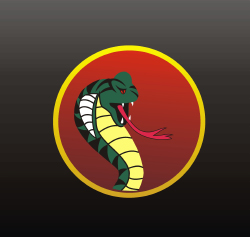
HML-367 unit logo placed on tail boom
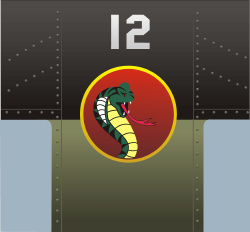
HML-367 nose art from 1971-75 period. The
aircraft number appeared in white over the unit logo.
|
|
|
|
|
|
|
|
|
|
|
|
|
|
|
| |
U. S. Marine Corps Hueys |
|
|
|
|
|
|
|
|
|
|
|
|
|
|
| |
As the Marine Corps became more
involved in Vietnam, the need for a small utility helicopter became
apparent. The Marines evaluated several types, but ultimately
settled on the Army Huey UH-1B/C model to meet their needs. However,
the Marines requested several modifications to the standard B/C
model. One important change was the use of aluminum for the body as
opposed to the Army's use of magnesium. Magnesium had a tendency to
corrode when exposed to salt air or water, and the Marines wanted a
material that would resist corrosion while operating from or being
transported on Navy ships. The Marines also requested a rotor brake
so the engine could be shut down quickly on the decks of ships. This
modified Huey model was designated the UH-1E, and was used
exclusively by the Marines during Vietnam.
The UH-1E was used for C&C,
medevac, visual reconnaissance and observation, and most other light
utility roles. At first Marine Corps Headquarters resisted the use
of the UH-1E in a gunship role. Eventually, however, it approved the development of armed gunship configurations. Instead of using the Army weapons mount system, the
Marines developed their own field expedient weapons platform called
the TK (Temporary Kit). Before the acquisition of the UH-1Es, the
Marines had attempted to arm some UH-34 Seahorse medium helicopters
with a prototype flexible mount system for the M-60 machine gun.
This was called the TK-1 kit. Though the armed UH-34 was not a success, the Marines began arming
UH-1E gunships with a modified weapons mount kit
called TK-2. This kit was used on Marine gunship-configured Hueys
throughout the Vietnam War.
In April 1967 the Marines also
began using an Emerson Electric chin turret called the TAT-101 on
their gunships. This chin turret carried two M-60 machine guns with
500 rounds. |
|
| |
|
|
|
|
|
|
|
|
|
|
|
| |
|
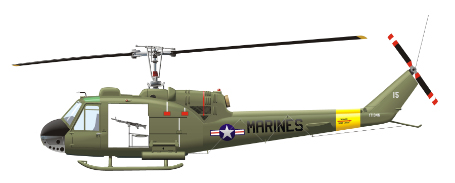 |
|
|
|
|
|
|
| |
|
|
click on helicopter illustrations to see larger images,
then click "back arrow" to return to this page |
|
|
|
| |
|
|
|
|
|
|
|
|
|
|
|
|
|
|
|
|
|
|
|
| |
1966 - UH-1E VMO-2 A
rocket-armed UH-1E as photographed at Dong Ha (I Corps) in 1966. Marine
Observation Squadron (VMO) Two deployed to Vietnam in May of 1965. Shortly
thereafter they received their first UH-1Es. In 1968 VMO-2 received OV-10A
Bronco fixed-wing aircraft to supplement their helicopter assets. In April
1969 they received their first AH-1G Cobra gunships, and a month later all
the squadron's UH-1Es were transferred to HML-167. At the end of 1969 the Cobras
were transferred to HML-367, and from that point VMO-2 flew only fixed-wing
OV-10's. In April 1972 VMO-2 was relocated to Camp Pendleton, CA.
The UH-1E illustrated here carried 2.75 inch rocket pods,
but side-mounted M-60 machine guns were not installed. However, this Huey
did carry defensive M-60s mounted on a metal post and swivel mount that
differed from the Army's M23 mount system in the cargo doorway. The cargo doors were removed
from the ship. This Huey, like most Marine UH-1E's had a tail boom-mounted
antenna. Also notice the lack of the vertical VHS antenna fin on the cabin
roof. Many (but not all) UH-1Es lacked the vertical VHS antenna fin.
Instead, Marine Hueys often carried a VHS antenna dome or housing on the
cabin roof - see the rounded hump or dome on the roof in the illustration.
This helicopter carried high visibility markings on the cabin sides -
vertical white stripes and red-painted step panels. There was also a
vertical red stripe on the engine cowling. The tailboom had a wide, high
visibility yellow band near the rear with a red arrow and the words "DANGER"
and "KEEP AWAY" painted in black. A six-digit aircraft number was painted in
white on the rear of the tailboom, and a larger, two-digit number was
painted on the tail. The "MARINE" legend on the tail boom was painted in
black, but on early war aircraft it could often be seen painted in white.
Early war helicopters also carried a full color national insignia just
forward of the MARINE legend. |
|
|
| |
|
|
|
|
|
|
|
|
|
|
|
| |
|
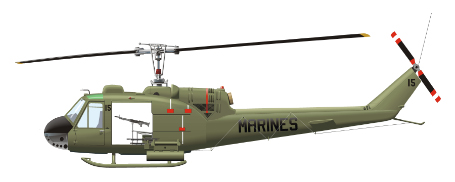 |
|
|
|
|
|
|
|
|
|
|
|
|
|
|
|
|
|
|
| |
1967 - UH-1E gunship VMO-6
A UH-1E gunship with VMO-6 based at Ky Ha near Chu Lai (I Corps)
in 1967. VMO-6 was tasked with flying armed escort for Marine
transport helicopters, so most of their Hueys during this period
were gunships. Marine rotary aircraft during this period wore more
subdued markings. The high visibility yellow tail boom band has been
removed. The aircraft number is painted in flat black on both the
frame behind the pilots' doors and the tail. The national emblem has
also been removed from the aircraft. The only high visibility
markings that remain are the red step covers and vertical stripes on
the cabin sides and engine cowling. Like most Marine UH-1Es, this
aircraft has a tail boom-mounted antenna and rounded housing on the
cabin roof. |
|
|
| |
|
|
|
|
|
|
|
|
|
|
|
| |
|
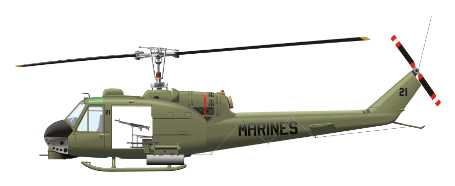 |
|
|
|
|
|
|
|
|
|
|
|
|
|
|
|
|
|
|
| |
1967 - UH-1E gunship VMO-3 This
gunship flew with VMO-3, based at Phu Bai in I Corps. Number 21 had a
TAT-101 chin turret in addition to the normal gunship armament. VMO-3 was
the first Marine unit to fly UH-1E gunships with chin turrets. This
aircraft's rocket pods were painted white (by 1967 most rocket pods were
painted OD). There was a vertical red stripe on the engine cowling. The
aircraft number was painted in black behind the pilots' doors and on the
tail. This Huey gunship was destroyed by an NVA rocket hit on January 29,
1968 while on the ground at Khe Sanh. Click button to see difference between
Army and Marine gunships armed with turrets. |
|
| |
|
|
|
|
|
|
|
|
|
|
|
| |
|
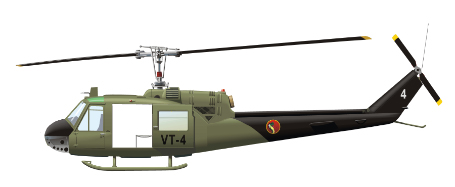 |
|
|
|
|
|
|
|
|
|
|
|
|
|
|
|
|
|
|
| |
1968 - UH-1E
slick VMO-3/HML-367 A UH-1E slick
as photographed in 1968. VMO-3 became HML-367 in April 1968. The
unit began painting the tail booms and tails of its Hueys flat
black. The unit logo, a cobra rearing up on a red disk, outlined in
yellow, was placed forward of the horizontal tail plane. The MARINE
legend was removed from their aircraft with this paint scheme. The
aircraft number was painted in black on the cargo door, and in white
on the tail. Interestingly, the tail boom antenna normally seen on
Marine Hueys is not present. This aircraft also did not have the
large rounded housing on the cabin roof usually seen on Marine
UH-1Es. HML-367 also flew Huey gunships with chin turrets until the
beginning of 1970. These gunships carried the same paint scheme and
markings. |
|
| |
|
|
|
|
|
|
|
|
|
|
|
| |
|
 |
|
|
|
|
|
|
|
|
|
|
|
|
|
|
|
|
|
|
| |
1970-71 - AH-1G
HML-367 At the end of 1969 HML-367 turned over its Huey
UH-1E gunships to HML-167. In place of the old E models they
received new Huey Cobra gunships. Aircraft VT-1 was the first
Cobra assigned to the unit. HML-367 Cobras flew with colorful nose
art depicting the face of a Cobra with bared fangs. The aircraft
number appeared in black underneath the cockpit, and on the upper
rear corner of the tail. The aircraft serial number was painted in
black at the bottom of the tail. Marine units usually displayed a
six-digit a/c number rather than the Army practice of displaying a
five-digit number. HML-367 moved from Phu Bai in December 1969 to
Marble Mountain Air Facility at Da Nang. They remained at Marble
Mountain until they left Vietnam in June of 1971. |
|
|
| |
|
|
|
|
|
|
|
|
|
|
|
| |
|
 |
|
|
|
|
|
|
|
|
|
|
|
|
|
|
|
|
|
|
| |
1975 - UH-1E
slick HML-367 HML-367
relocated to MCAS Futenma on Okinawa when they left Vietnam in June,
1971. After leaving Vietnam, high visibility markings were
once again placed on Marine helicopters. Aircraft numbers and the
MARINE legend are painted in white. The color national emblem
reappears on the tail boom. The yellow warning band at the rear of
the tail boom also reappears. HML-367 Hueys carried the unit logo on
the nose at this time. Six UH-1Es from this unit participated
in the final evacuation of Saigon in April 1975 ("Operation Frequent
Wind"). They flew from one of the carriers operating off the coast
during the evacuation. |
|
|
| |
|
|
|
|
|
|
|
|
|
|
|
| |
|
|
 |
|
 |
|
|
|
|
| |
|
|
|
|
|
|
|
|
|
|
|